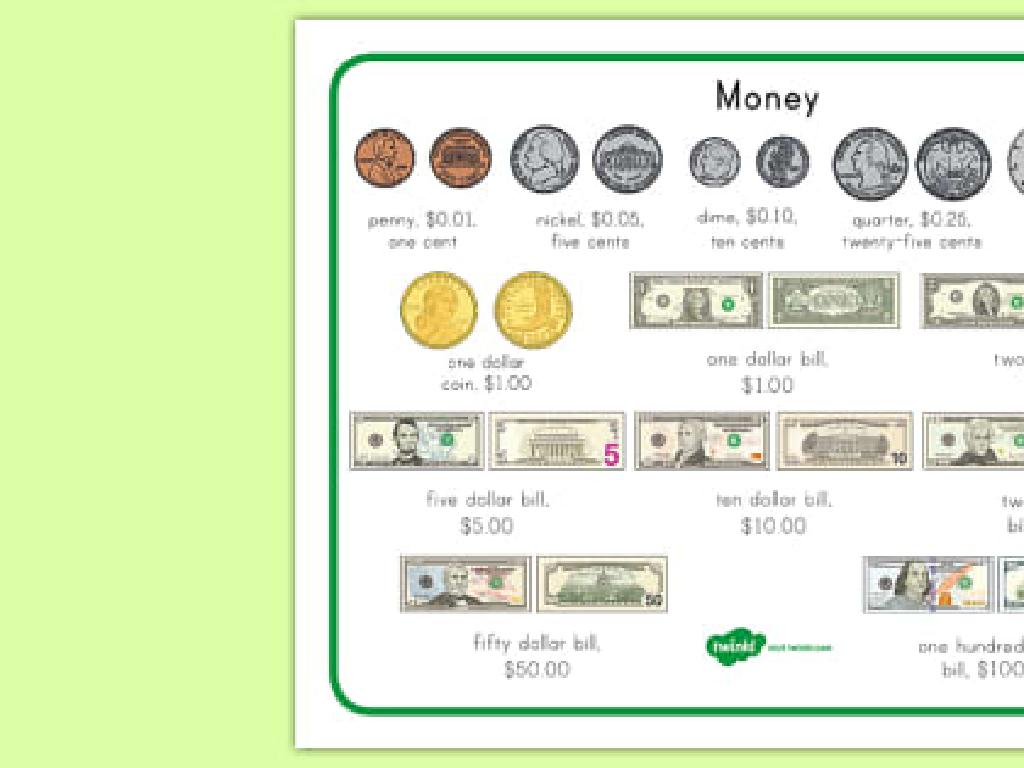The Gilded Age (1865-1898)
Subject: Arts and humanities
Grade: High school
Topic: Us History
Please LOG IN to download the presentation. Access is available to registered users only.
View More Content
Welcome to The Gilded Age (1865-1898)
– Unveiling The Gilded Age era
– Decoding the term ‘Gilded Age’
– ‘Gilded’ implies a shiny surface hiding deeper problems beneath
– Mapping out today’s lesson
– Setting our learning objectives
– We aim to understand the era’s key events and societal contrasts
|
This slide introduces students to The Gilded Age, a period in US history characterized by rapid economic growth and a facade of prosperity that masked underlying social issues. The term ‘Gilded Age’ itself, coined by Mark Twain, suggests a glittering surface that covers something of lesser quality. Today’s lesson will provide an overview of this transformative era, focusing on its main events, technological advancements, and the stark contrast between wealth and poverty. By the end of the lesson, students should be able to identify the key characteristics of The Gilded Age and understand its impact on modern America. Encourage students to think critically about the parallels between the Gilded Age and contemporary society.
The Origin of the Term ‘Gilded Age’
– Coined by Mark Twain
– Twain used ‘Gilded Age’ to critique post-Civil War era excesses.
– ‘Gilded’ vs. ‘Golden’: A Satire
– ‘Gilded’ implies cheap base metal with a thin gold layer, unlike ‘golden’ which suggests solid value.
– Reflects societal disparities
– Highlights the era’s stark contrast between the wealthy elite and the poor.
– Nickname’s deeper meaning
|
Mark Twain coined the term ‘Gilded Age’ to satirize the post-Civil War era, characterized by rapid economic growth and a facade of prosperity, which masked underlying social issues, including stark economic inequality. The term ‘gilded’ was chosen deliberately to contrast with ‘golden’; while something golden is made entirely of gold, something gilded only has a superficial layer of gold, suggesting falseness beneath the surface. This metaphor was Twain’s commentary on the era, where the opulence enjoyed by the few was not indicative of the experiences of the many. The nickname ‘Gilded Age’ thus carries with it implications of an era that glittered on the surface but was, in reality, fraught with problems like corruption, social stratification, and exploitation.
Economic Growth and Industrialization in the Gilded Age
– Industrial boom and technological advances
– Innovations in steel production, telegraph, and telephone
– Influential tycoons: Carnegie, Rockefeller, Vanderbilt
– Andrew Carnegie in steel, John D. Rockefeller in oil, Cornelius Vanderbilt in railroads
– Railroad expansion’s role
– Railroads connected the country, opening new markets
– Transformative impact on society and economy
|
This slide delves into the rapid economic growth during the Gilded Age, marked by a surge in industrialization and technological innovation. Highlight the key figures of the era, such as Andrew Carnegie, John D. Rockefeller, and Cornelius Vanderbilt, who became synonymous with the wealth and power of the period. Discuss the pivotal role of the railroad expansion in connecting the country, facilitating trade, and spurring further industrial development. The transformative impact of these changes on society and the economy should be emphasized, including the rise of urban centers, the creation of jobs, and the increase in production and consumption. Encourage students to consider both the positive and negative effects of this growth, setting the stage for discussions on labor conditions and economic disparity.
Social Issues of The Gilded Age
– Wealth vs. Poverty disparity
– The vast gap between the rich and the poor during this era
– Urbanization challenges
– Overcrowding, sanitation, housing were major urban issues
– Emergence of labor unions
– Workers formed unions to demand better conditions and pay
– Strikes as a form of protest
– Strikes became common as workers fought for rights
|
This slide addresses the significant social issues during The Gilded Age, a period of rapid economic growth but also great social inequality. The disparity between the wealthy elite and the impoverished working class was stark, with the rich living lavishly while many others struggled to survive. Urbanization brought people to cities, leading to problems such as overcrowding, poor sanitation, and inadequate housing. In response to harsh working conditions and low wages, labor unions gained momentum, organizing strikes and other forms of protest to demand better treatment and pay for workers. These issues are crucial for understanding the complexities of this era in U.S. history and the roots of modern social and labor movements.
Politics in The Gilded Age
– Rise of political machines
– Organizations controlling votes and city politics, e.g., Tammany Hall
– Government’s role in the era
– Laissez-faire policies, limited intervention in economy
– Key legislation passed
– Sherman Antitrust Act, Pendleton Civil Service Act
– Influential political figures
– Boss Tweed, Thomas Nast, President Ulysses S. Grant
|
This slide delves into the political landscape of The Gilded Age, marked by the emergence of political machines like Tammany Hall, which were often associated with corruption and control over urban politics. The government generally took a laissez-faire approach, with minimal interference in the economy. However, significant legislation such as the Sherman Antitrust Act and the Pendleton Civil Service Act were enacted to curb corruption and regulate business practices. Key political figures of the time include Boss Tweed, a symbol of political corruption, Thomas Nast, a political cartoonist who exposed corruption, and President Ulysses S. Grant, whose administration was tainted by scandals. Encourage students to explore the impact of these political machines and figures on the American society and economy of the time.
Culture and Society During The Gilded Age
– Impact of arts and literature
– Arts and literature reflected and shaped societal values and issues of the time, such as Mark Twain’s works.
– Daily life and leisure in the era
– Leisure activities included new sports like baseball and social clubs, reflecting the era’s prosperity.
– Education during The Gilded Age
– Education reform focused on compulsory schooling laws, expanding access to education.
– Social reforms of the time
– Reforms addressed issues like labor laws, women’s suffrage, and temperance.
|
This slide aims to encapsulate the cultural and societal shifts during The Gilded Age. Highlight how the arts and literature served as both a reflection of and an influence on the society of the time, with authors like Mark Twain critiquing the era’s materialism. Discuss the emergence of leisure activities as a result of industrialization and increased wealth, which led to more free time for certain classes. Touch on the significant changes in education, including the push for compulsory education and the establishment of more public schools. Lastly, delve into the social reforms that began to emerge in response to the problems of industrialization, such as the labor movement, the fight for women’s suffrage, and the temperance movement. Encourage students to think about the parallels between the social reforms of The Gilded Age and those of modern times.
The Close of The Gilded Age
– Key events ending The Gilded Age
– Economic panics, labor strikes, and political reforms signaled the end.
– Transition to the Progressive Era
– Progressive Era marked by social activism and political reform.
– Reflecting on The Gilded Age’s impact
– Consider the era’s advancements and inequalities.
– Understanding the era’s complexities
– Recognize the juxtaposition of opulence and poverty.
|
This slide aims to encapsulate the transition from The Gilded Age to the Progressive Era, highlighting the significant events that led to the end of an era characterized by rapid economic growth and glaring social inequalities. Discuss the economic panics, such as the Panic of 1893, and the labor strikes that underscored the need for change, leading to the rise of the Progressive Era. Encourage students to reflect on the legacy of The Gilded Age, considering both the technological advancements and the deep social issues that arose. The discussion should also touch on the complexities of the era, understanding that it was a time of both great wealth and widespread poverty, setting the stage for the reforms that the Progressive Era would attempt to address.
Class Activity: Analyzing Primary Sources from The Gilded Age
– Examine era-specific photographs
– Analyze political cartoons
– Review firsthand historical accounts
– Group discussion and presentation
– Share different perspectives and complexities of the era
|
This activity is designed to engage students with primary sources from The Gilded Age to foster a deeper understanding of the period. Provide students with a diverse set of photographs, political cartoons, and firsthand accounts to analyze. Encourage them to look for underlying themes, societal commentary, and the historical context behind the sources. In groups, students should discuss the different perspectives these sources represent and what they can infer about the era. Each group will then present their findings to the class, highlighting the complexities and varied experiences of The Gilded Age. Possible activities: 1) Comparing immigrant vs. tycoon perspectives, 2) Analyzing labor conditions through photographs, 3) Interpreting political cartoons about monopolies, 4) Reading diary entries from different social classes, 5) Discussing the impact of industrialization as seen in various accounts.






